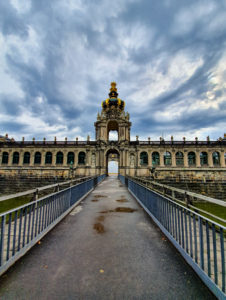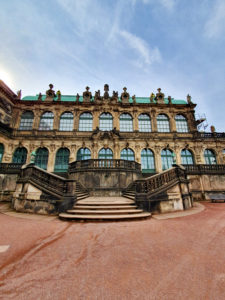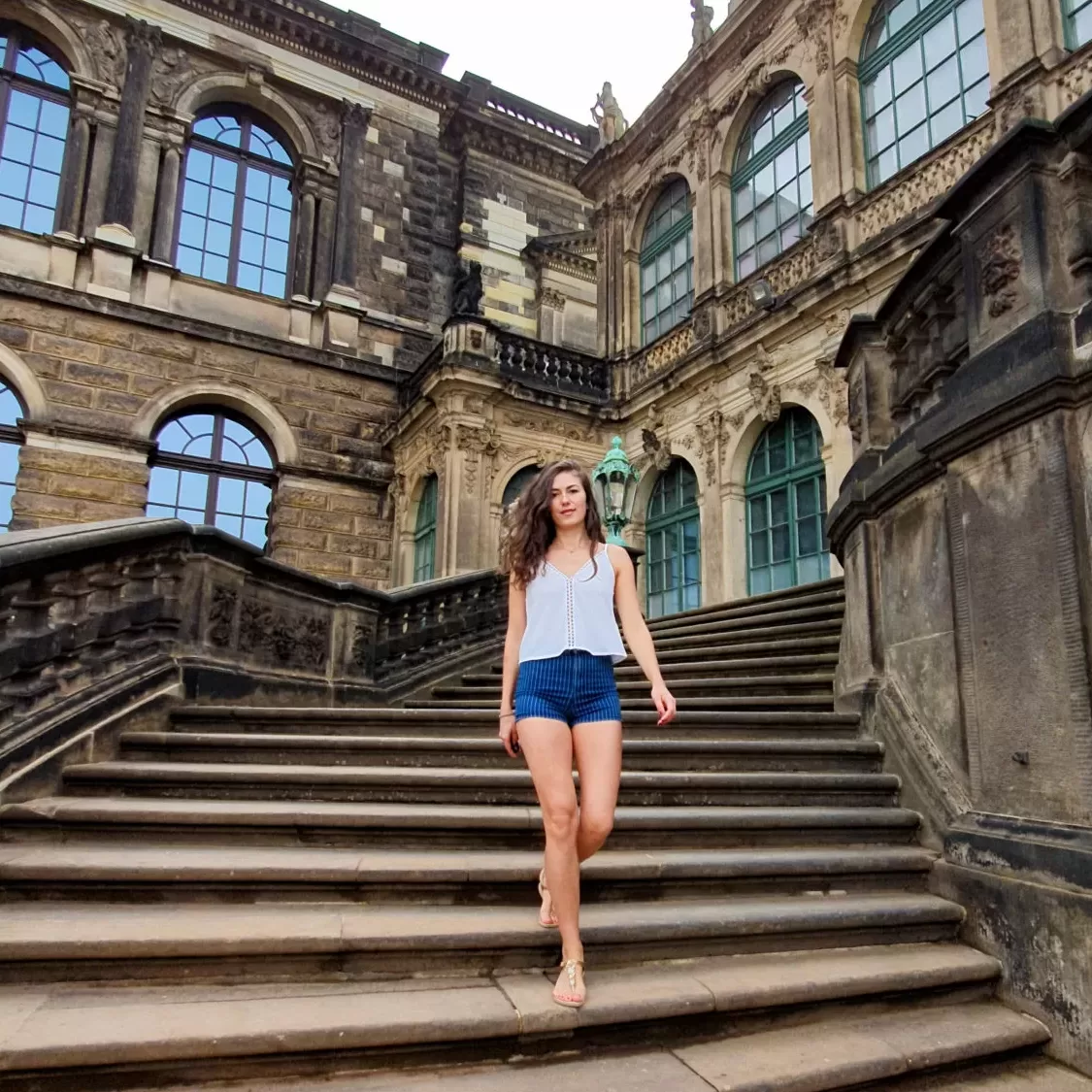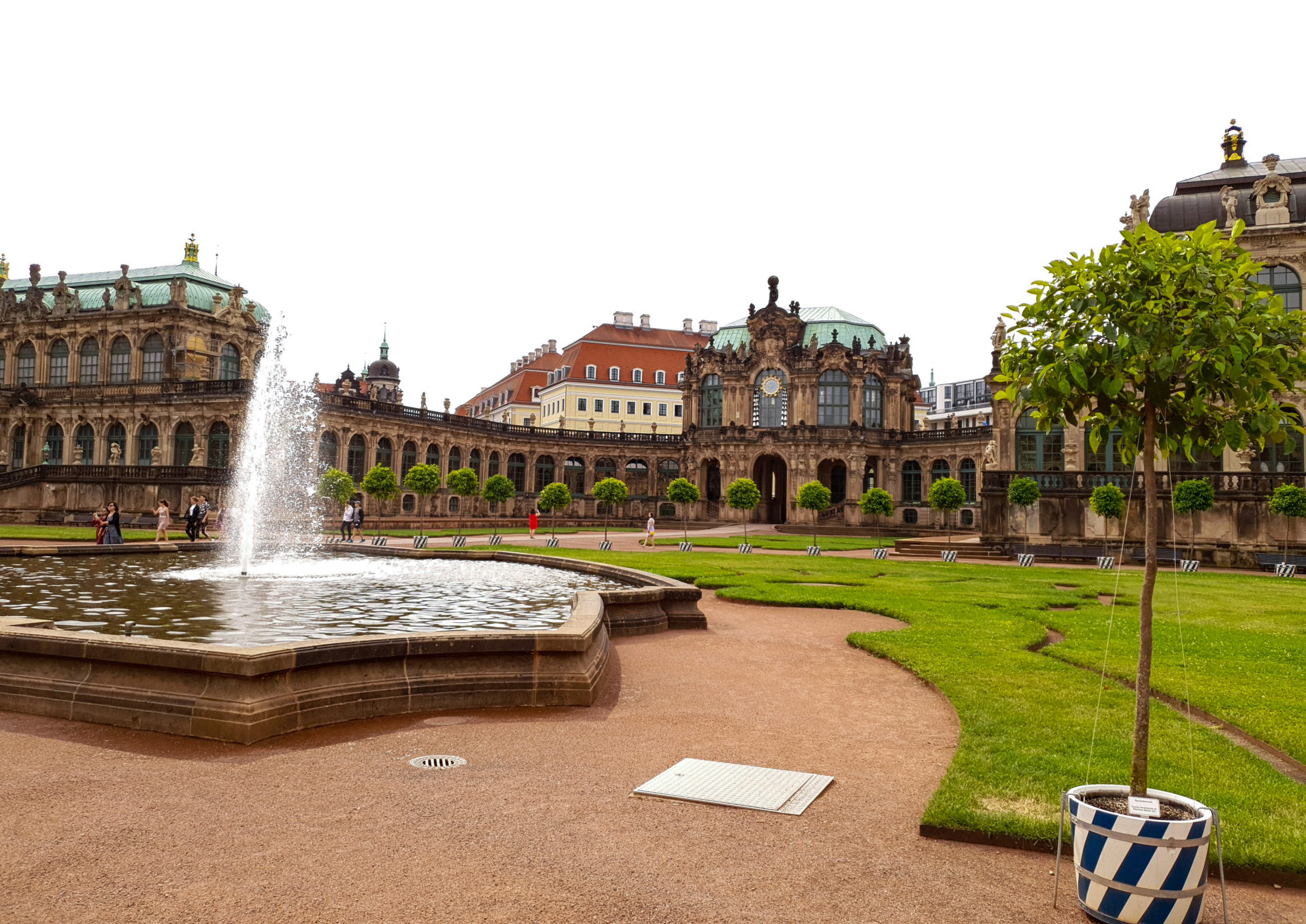Dresden was historically known as the Jewel Box due to the architecture of the old town, mostly Baroque and Rococo. Here is all you need to know about visiting this beautiful German city.
This page contains affiliate links. If you buy through these links, I may receive a small commission, at no additional cost to you. I only recommend products or services I have tried and/or find useful and reliable.
I traveled to Dresden while living in Berlin between 2019 and 2020. It was one of the first day trips I took, and I immediately loved this city. It’s probably fair to say that Dresden has the most stunning architecture in Germany. However, the city also has a tragic history. Keep reading to find out what makes Dresden unique and what are the must-see places.
Getting to Dresden
Dresden is the capital city of the Saxony region, in the east of Germany, near the border with the Czech Republic. Dresden Airport is only 20 minutes away by train and has plenty of international flights.
You can also reach Dresden by bus (Flixbus has a range of cheap options). It takes about 3.5 hours from Berlin, and 2 hours from Leipzig or Prague. The train is also an option, but it might take longer, and you need to buy your tickets in advance for good prices.
Dresden has two main bus stations and several train stations, so it’s pretty easy to reach from different parts of Germany and not only. The city itself is quite big, but the old town can be easily discovered just by walking.

Dresden’s tragic history
Before going to Dresden, I didn’t know what to expect. I did my research, and it looked like an interesting city with some cool architecture, so I decided to go check it out. I have to say it was an incredible discovery of a city with a lot of history.
There’s a good reason Dresden was known as the Jewel Box: the city center is an authentic jewel. Stunning Baroque architecture, big squares, magnificent churches, the unmissable Zwinger Palace, and the iconic Semperoper.
Unfortunately, the British/American bombing of Dresden at the end of World War II led to the destruction of most of the old town. Four raids destroyed 90% of the city center, killing around 25,000 people. This was one of the most controversial events of the War, which would profoundly impact the city in the years to come. The unjustified attack that damaged such an important and beautiful cultural landmark shocked even the intellectual circles in Britain.
The city took many years to recover. Important buildings such as the Frauenkirche, Semperoper, and the Zwinger Palace required several years and great efforts to be rebuilt.
The reconstruction of the Zwinger Palace started immediately after the war and took almost 20 years. The Semperoper reopened in 1985, exactly 40 years after the bombing. The remains of the Frauenkirche were left as a war memorial for 50 years before reconstruction started. The rebuilt church was only reconsecrated in 2005.
It is truly incredible to see how this city, almost entirely destroyed, managed to rise again from its ashes and go back to its historical grandeur.
The Baroque city: Altstadt
The old town is the place to go to in Dresden. This is where most of the landmarks and buildings are located. You will mostly see sophisticated and elaborate baroque and rococo buildings and wide squares. Let’s check out the main landmarks.
Dresden Zwinger

This palace is probably the most stunning one in Dresden. Augustus the Strong, King of Poland, ordered the construction of the palace when he returned to Dresden after a visit to Luis XIV’s court in Versailles. He was amazed by the French palace and decided he wanted something as magnificent for himself. The name of the place, Zwinger, dates back to the Middle Ages when it referred to the killing ground in front of a castle or city gate.
The place served as the orangery, exhibition gallery, and festival arena of the Dresden Court. The courtyard used to contain the most spectacular orange garden back in 1710. At one point the orange trees got removed, but they have been back since 2017. In summer you can enjoy their flowers and perfume.
Several statues decorate the Wall Pavillion, on the north side, including Hercules holding the World. On the west side, admire the Crown Gate (Kronentor). The gate opens up at the end of a bridge on the moat that used to surround the palace grounds. This used to be the main entrance to the palace gardens, while on the opposite side, Sempergalerie is the latest addition to the architectural complex.


Today, the museum complex includes the Old Masters Picture Gallery, the Dresden Porcelain Collection, and the Royal Cabinet of Mathematical and Physical Instruments. You can visit or simply walk around the gardens for free. Enjoy the fountains and carefully manicured lawns and trees. Take a closer look at the details of the stunning baroque architecture and find the Nymph Baths hidden behind the French Pavilion.
This is my favorite place in Dresden and whether you are a fan of baroque architecture or not, it’s an undeniably beautiful construction. During your visit, you can also download this app that will guide you through the various areas and tell you more about the history of the place and how it changed over the years.
Semperoper
Semperoper is the opera house of the Saxon State Opera and the concert hall of the Saxon State Orchestra. You will find it in Theaterplatz, right outside the Zwinger and near the Elbe River. Major works have premiered here over the decades, including some by Richard Wagner and Richard Strauss.

The building is a great example of Dresden Baroque architecture. Even after the Dresden bombing, it was rebuilt almost exactly as it was before, with the added benefit of new and updated stage machinery. When it reopened after the bombing on 13 February 1985, it was with the same opera that was last performed before its destruction, Der Freischütz by Carl Maria von Weber.
You can admire the building from the outside, in Theater Square, or buy a ticket for a guided tour of the interior if you have enough time to dedicate. And if you’re passionate about opera, this is a great place to enjoy a play.
Katholische Hofkirche
The Katholische Hofkirche is the Catholic Cathedral of Dresden, also known as the Cathedral of the Holy Trinity. It was always the most important Catholic church in the city and was elevated to the cathedral status in 1964. It is located near the Elbe River in the historic center of Dresden, right near Augustus Bridge.

The Cathedral is also one of the burial sites of the House of Wettin, including Polish monarchs. The bombing of Dresden damaged this church, as most of the buildings in Altstadt. The restoration of the church ended in 1962. Unfortunately, the surrounding area was under construction when I went there, so the view was a bit ruined, but it’s definitely an amazing building. Also, you can visit it for free.
Dresden Castle
Also called the Royal Palace, this is one of the oldest buildings in Dresden. Over the years, it has served as the residence of the electors and kings of Saxony. Nowadays, it holds several art collections and museums. Here you can find the Historic and New Green Vault with the largest collection of treasures in Europe, the Numismatic Cabinet with thousands of coins, the Collection of Prints, Drawings, and Photographs, and the Dresden Armory with the Turkish Chamber.
The palace also houses an art library and the management of the Dresden State Art Collections. If you have any interest in any of these things, make sure to go for a visit. Or just enjoy the view of the castle from the outside and take a walk in the gardens.

Fürstenzug
The Fürstenzug, literally Procession of Princes, is a large mural depicting the rulers of Saxony on horseback. Although it was painted between 1871 and 1876, it was entirely replaced with porcelain tiles from Meissen between 1904 and 1907 to make it waterproof. It was created in honor of the 800th anniversary of the Wettin Dynasty, the ruling family of Saxony. The mural is now famous for being the largest porcelain artwork in the world.

The Fürstenzug is located near Dresden Castle, on Augustusstrasse. It is quite an impressive piece of art so make sure you don’t miss it.
Brühlsche Terrasse
Brühl’s Terrace is an impressive architectural ensemble known as “The Balcony of Europe”. The terrace overlooks the Elbe River and is just a few minutes away from Neumarkt Square. It’s a lovely place to go for a walk and enjoy the view of the river and the “new town” of Dresden on the other side. Have a coffee on one of the terraces or simply sit on the benches facing the river.

Underneath Brühl’s Terrace, you will find Dresden’s Fortress. Here you can discover the oldest Renaissance structures in the city, including Brick Gate, the only city gate in Dresden still existing, dating back 400 years. The Fortress has recently undergone renovations and reopened with a brand new multimedia exhibition meant to take you back in time and show you Dresden’s history. Check out more info and buy tickets on the official website.
Frauenkirche
The Frauenkirche, or Church of Our Lady, is a baroque Lutheran church, originally built as a Catholic church and then turned Protestant during the Reformation.
The church has one of the largest domes in Europe and is considered a great example of Protestant architecture. Although the bombing of Dresden destroyed it almost entirely, the reconstruction was faithful to the original.

The church is located in Neumarkt Square, which was also destroyed during the bombing and reconstructed only much later. Frauenkirche is an iconic landmark in the city, also due to its location. The surrounding square is filled with bars, restaurants, and souvenir shops. It’s a must-see for everyone visiting Dresden. In front of the church, you can spot a sculpture of Martin Luther. You can visit the church and climb up to enjoy a view from the top.
Kreuzkirche
The Lutheran Dresden Kreuzkirche (Church of the Holy Cross) is the largest church in the Free State of Saxony. For an architectural change, this is a Romanesque basilica dedicated to Saint Nicholas. It was built back in the 12th century and is located in the corner of Dresden Altmarkt.
For a 4€ entrance fee, you can climb to the top for a stunning view of the whole city of Dresden. From here you can see Frauenkirche, Dresden Castle, the Townhall tower, and even Dreikönigskirche, situated in Dresden Neustadt, on the other side of the river. Although both Frauenkirche and Dreikönigskirche have viewing points, I chose this one and was not disappointed.

Großer Garten
Close to Dresden Innere Altstadt, you can find an immense green area, housing Dresden Zoo and the Großer Garten (Great Garden). This is a Baroque-style park extending over almost 2 km². The park was originally established in 1676, and it became a public garden in 1814. This is an amazing place to enjoy nature and pure air, with beautifully decorated pathways with colorful flowers. The Sommmerpalais in the center of the garden is yet another gorgeous Baroque palace.

In the Great Garden, you will also find the Dresden Botanical Garden as well as a miniature railway, the Parkeisenbahn. It operates from April to October, taking you on a tour of the park.
Neustadt
Once you’re done with visiting Dresden Altstadt (old town), you can cross Augustus Bridge (Augustusbrücke) over the Elbe and head to Neustadt. Innere Neustadt also contains many important buildings in Dresden. After the war, it was reconstructed in baroque style.
As soon as you cross the bridge, you will be greeted by the Golden Rider, Goldener Reiter in German. This is the statue of Augustus the Strong (Elector of Saxony and King of Poland). August the Strong and his son Frederick Augustus II are the ones who ordered the construction of many of the baroque buildings that made Dresden famous. These buildings are the reason why the city got the name of “Florence on the Elbe”.

To the left, on the riverbank, you will find the Japanese Palace. This is yet another beautiful Baroque building, initially built to store Augustus the Strong’s Japanese porcelain collection, now part of the Dresden Porcelain Collection. The building was used as a library instead, while today it contains three museums: the Museum of Ethnology Dresden, the State Museum for Pre-History, and the Senckenberg Natural History Collection.
From the Golden Rider, you can walk down an alley lined with trees until you get to the Three Kings Church or Dreikönigskirche. I already mentioned this as another building offering a great view from the top.

Shopping in Dresden
If you are looking for a shopping area, make sure to check out Altmarkt-Galerie Dresden. The shopping gallery is located in Altstadt, right next to Altmarkt, the big square near Kreuzkirche. There are over 200 shops, restaurants, and cafés, so a great choice for every taste.
Just a few minutes away, Prager Strasse is a shopping street with many shops, cafés, and another shopping mall, the Centrum Galerie.
Where to eat in Dresden
There are plenty of good places to eat in Dresden, from local cuisine to the most exotic ones. If you are searching for a place in Altstadt, you can find a few options right around Frauenkirche. Choose Hofbräu zur Frauenkirche for German cuisine or Burgerei for tasty homemade burgers with a view of Neumarkt.
Just a few steps away, you can also find the Italian L’Osteria. But really, there are so many choices that I’m sure the hardest part will be choosing one. Even in the very center, you can find nice restaurants at decent prices.
Where to stay in Dresden
If you are looking to spend the night in Dresden, you will find that it’s not very cheap. Nevertheless, if you are on a budget, you can check out Hostel Mondpalast in Neustadt. If you want to stay closer to Altstadt, Star G Hotel Premium has great rates, especially if you book ahead of time.
If you can spend a little more, Hyperion Hotel is right in the heart of Dresden Altstadt, while Hotel Suitess offers stunning views of the Frauenkirche. Check more options on Booking.com or on the map below.
There could be so much more to say about this beautiful city, but I guess we covered the basics for a first short trip. You can find additional information on the official Dresden tourism website. If you have more time, you can go visit the nearby town of Meissen. Check out the short city break guide on this lovely little town here.
Travel Resources
Start planning your trip to Dresden with these apps and platforms. I use these resources on every trip and always have great experiences.
| Website/App | Category | Description | Book Here |
|---|---|---|---|
| Booking.com | Accommodation | My favorite website for great accommodations for different budgets. | Find a Place |
| Kiwi.com | Flights | My new favorite platform for finding affordable flights. | Find Flights |
| Omio | Transportation | You can book everything from buses and trains to ferry rides. | Transportation |
| SafetyWing | Insurance | One of the best travel medical insurances for frequent travelers. | Get Insured |
| Manawa | Activities | A great platform to book activities and adventures with local hosts. | Find Activities |
| GetYourGuide | Activities | My go-to platform for tours and experiences with lots of options. | Experiences |
| Viator | Activities | A great alternative for activities all over the world. | Experiences |
| GuruWalk | Free tours | A great platform for free walking tours (tipping is recommended). | Book a tour |
| DiscoverCars | Car rental | My go-to platform for car rental anywhere in the world. | Rent a Car |
| Airalo | eSIM | My favorite app for buying digital SIM cards when traveling abroad. | Get an eSIM |
| Saily | eSIM | A great alternative to Airalo, with cheaper plans in some destinations. | Get an eSIM |
| Xe | Currency | A currency converter showing real-time rates. Website or app. | Get Xe App |
| Maps.me | Navigation | My favorite navigation app for hiking trails and remote areas. | Get Maps |
Enjoy this stunning baroque city. Happy travels!


![12 Reasons to Visit Saxon Switzerland National Park [in 2025]](https://travelwithneweyes.com/wp-content/uploads/2019/08/20190817_164117_edited-1024x763.jpg)

